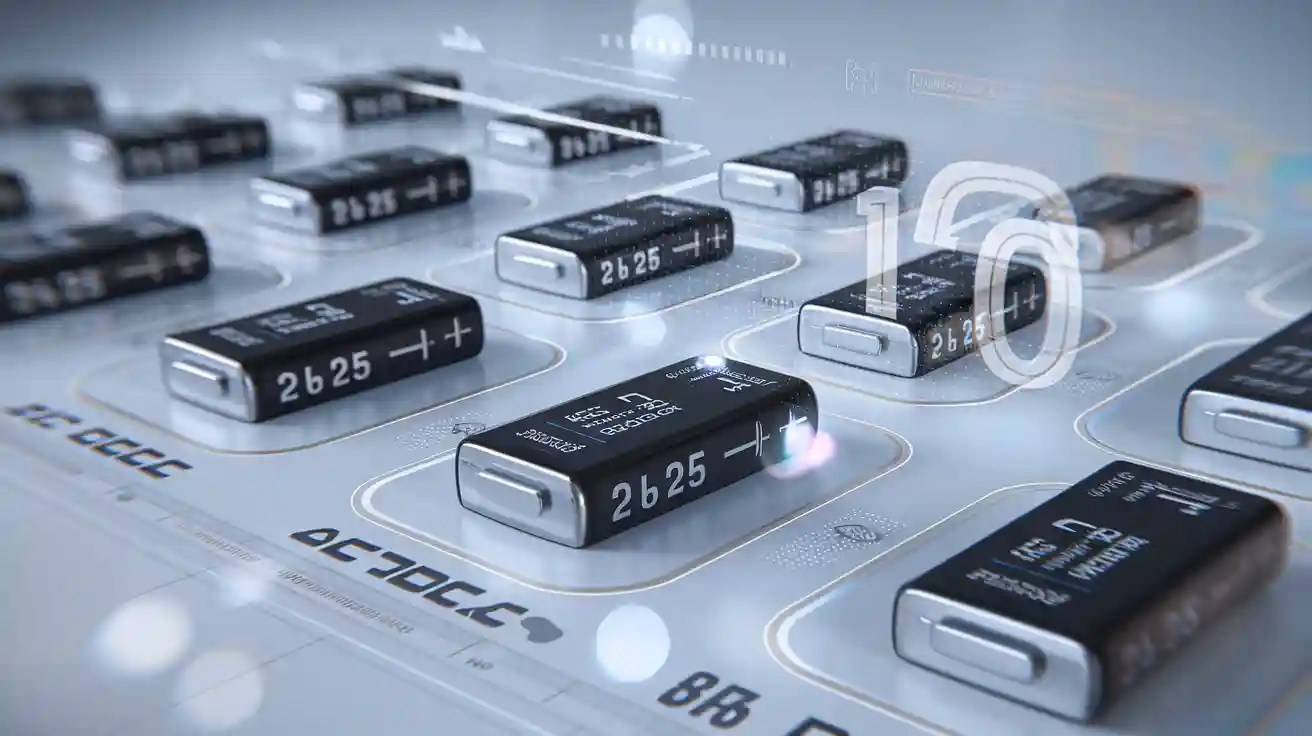
Here are the top 10 recommended types of 3.7v Lithium Ion Battery options you’ll want for 2025:
- High capacity 18650 Lithium Ion Battery cells
- High discharge rate Lithium Ion Battery packs
- Protected button top Lithium Ion Battery batteries
- Flat top Lithium Ion Battery cells
- Compact pouch Lithium Ion Battery designs
- LiFePO4 3.7v Lithium Ion Battery options
- 14500 and 16340 Lithium Ion Battery cells
- 21700 and 16650 Lithium Ion Battery cells
- Battery packs with PCM for Lithium Ion Battery safety
- Custom DIY Lithium Ion Battery assemblies
You see these rechargeable Lithium Ion Battery options everywhere—from smartphones and laptops à flashlights, drones, and portable devices. They’re the best for electronics and DIY because they offer a mix of safety, power, and long life. The global Lithium Ion Battery market shows huge growth, reaching $194.66 billion in 2025.

Matching the right 3.7v Lithium Ion Battery features like capacity, chemistry, and protection helps you get the most reliable rechargeable battery for your consumer electronics or DIY project. You’ll find 3.7v Lithium Ion Battery cells in all sorts of rechargeable gadgets, including power tools, electric toys, portable speakers, and backup power for household electronics.
Choose your top Lithium Ion Battery based on what your device or project needs most—runtime, safety, or compact size.
Selection Criteria for Lithium Ion Battery
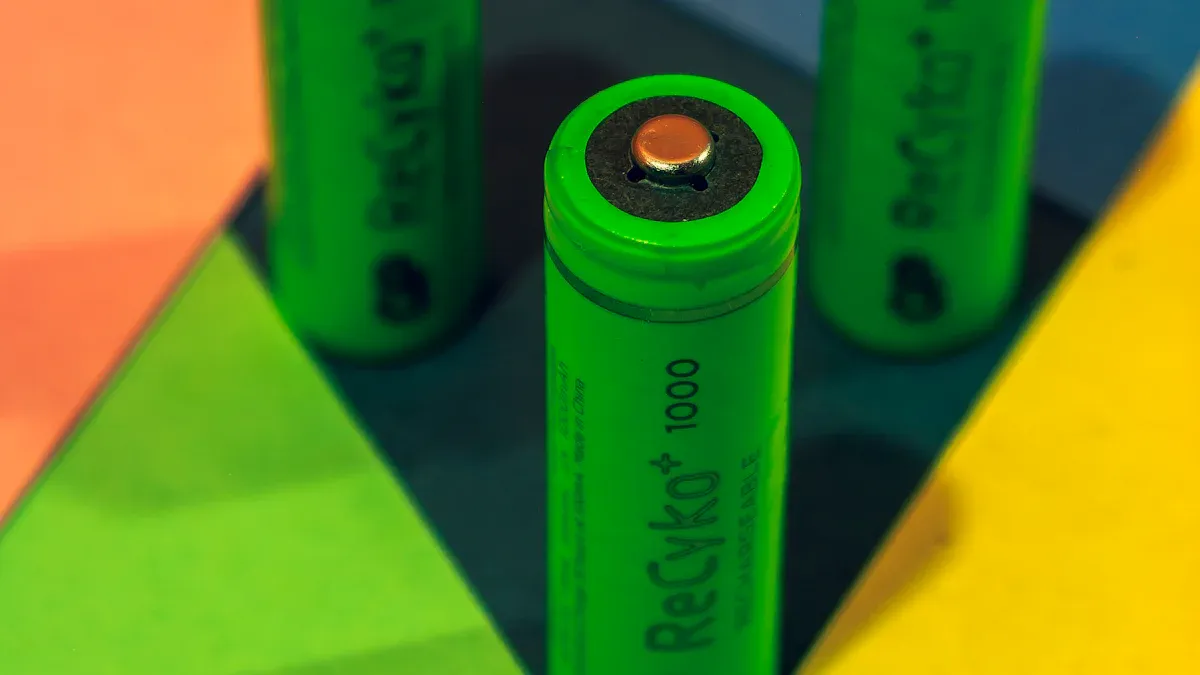
Capacité et durée d'utilisation
When you pick a 3.7v lithium ion battery, capacity is one of the most important factors to consider when choosing 3.7v batteries. Capacity, measured in milliamp-hours (mAh), tells you how much energy the battery can store. A higher capacity means your rechargeable battery will last longer before you need to recharge it. For example, if you use a 2000mAh 3.7v battery in a low-power device, you might get 5 to 10 hours of use. The formula is simple: Battery life (hours) = Amp-hour rating / Device current draw. So, if you want a long-lasting charge, always check the capacity first.
Taux de décharge
Les discharge rate is another key factor to consider when choosing 3.7v batteries. This tells you how fast the battery can deliver energy to your device. High-drain devices like power tools or e-bikes need a lithium ion battery with a high discharge rate. If you use a battery with a low discharge rate in a high-power device, you might see poor performance or even damage. Always match the discharge rate to your device’s needs for reliable performance.
Safety and Protection
Safety should always be at the top of your list when picking 3.7v batteries. Modern lithium-ion batteries come with built-in safety features. These include protection circuits that stop overcharging, over-discharging, and short circuits. Some batteries have PTC devices to prevent high current surges, and CIDs that break the circuit if pressure gets too high. You also get safety vents and fuses for extra protection. These features help prevent accidents and keep your rechargeable battery safe.
Tip: Always choose a lithium ion battery from a trusted brand to ensure the best safety and quality.
Chemistry Types
You will find several chemistry types in 3.7v lithium ion battery options. Each type offers different energy density, safety, and lifespan. Here’s a quick table to help you compare:
| Chemistry Type | Energy Density | Sécurité | Lifespan | Best Use |
|---|---|---|---|---|
| LiCoO2 | Haut | Moyen | Moyen | Phones, laptops |
| LiMn2O4 | Moyen | Haut | Faible | Power tools |
| LiFePO4 | Faible | Very High | Haut | Solar, storage |
| NMC | Haut | Haut | Haut | EVs, tools |
| ANC | Very High | Faible | Haut | High-performance EVs |
If you want high energy density, look for NMC or NCA. For top safety, LiFePO4 is a great choice.
Application Suitability
The last of the factors to consider when choosing 3.7v batteries is matching the battery to your device. High-drain devices need batteries with high energy density and a high discharge rate. Low-drain devices can use batteries with lower capacity and slower discharge. Always check the size and shape to make sure the battery fits. Lithium polymer batteries are great for slim gadgets, while cylindrical cells work well in flashlights and tools. Think about your device’s energy needs, runtime, and safety before you buy.
- For high-drain: Use high-capacity, high discharge rate 3.7v batteries.
- For low-drain: Choose batteries with longer shelf life and steady energy output.
By focusing on these factors to consider when choosing 3.7v batteries, you can find the right rechargeable battery for any project. This helps you get the best battery performance, energy storage, and safety every time.
Top 10 Recommended Types of 3.7V Batteries
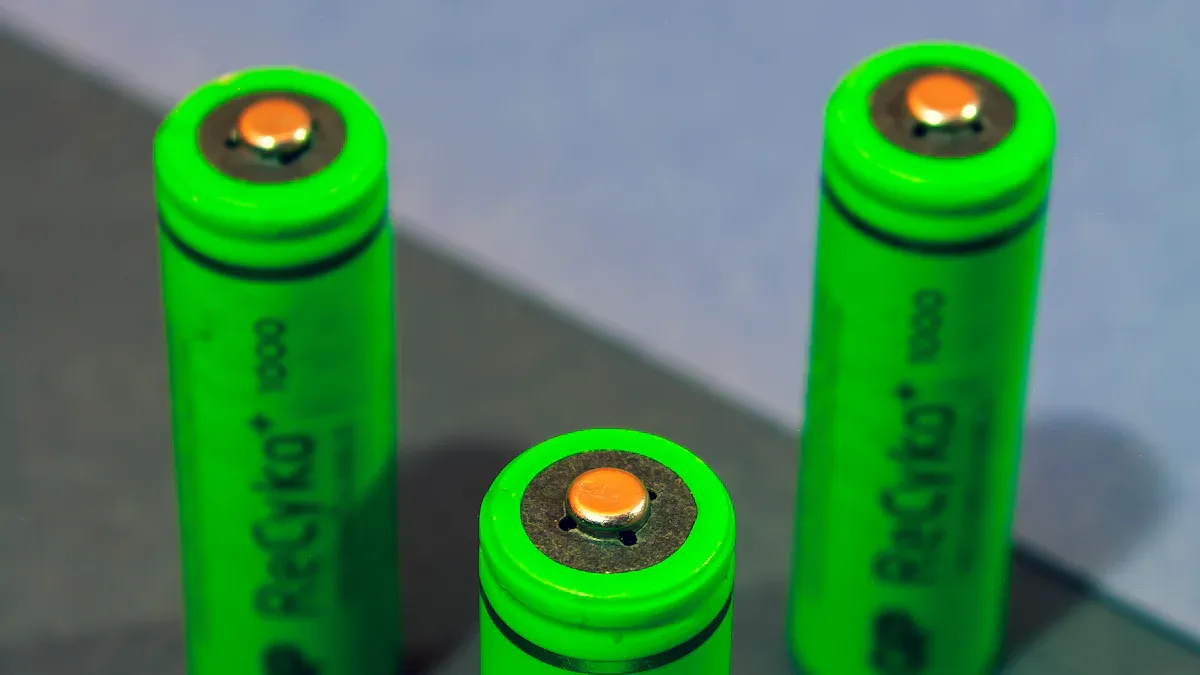
High Capacity 18650 Cells
If you want a long-lasting charge for your device, high capacity 18650 cells are a top pick from the top 10 recommended types of 3.7v batteries. These lithium-ion battery cells pack a lot of energy into a small size, making them perfect for flashlights, laptops, and power banks. You get high energy density and reliable performance, which means your rechargeable battery lasts longer between charges.
Here’s a quick look at some of the most popular high capacity 18650 lithium-ion battery cells in 2025:
| Manufacturer | Modèle | Capacité (mAh) | Nominal Voltage (V) | Max Voltage (V) | Max Continuous Discharge Current (A) |
|---|---|---|---|---|---|
| Panasonic | NCR18650G | 3600 | 3.6 | 4.2 | 4.87 |
| LG | INR18650-M36 | 3600 | 3.6 | 4.2 | 10 |
| Samsung SDI | INR18650-36G | 3600 | 3.6 | 4.2 | 10 |
You’ll find these batteries use advanced chemistries like NCA and NMC, which boost energy density and capacity. They work well in consumer electronics and portable devices where you need both power and runtime. If you want a rechargeable battery that keeps your gadgets running, these 18650 cells deliver.
Tip: Always check the max discharge current to match your device’s needs for safe and reliable battery performance.
High Discharge Rate Batteries
Some devices need a burst of power. High discharge rate 3.7v batteries are built for this. You’ll see them in power tools, e-bikes, and electric scooters. These lithium-ion battery packs can handle heavy loads without losing energy or overheating.
A great example is the HAKADI 18650:
| Battery Model | Tension nominale | Capacité | Max Continuous Discharge Current | Discharge Rating (C) | Applications |
|---|---|---|---|---|---|
| HAKADI 18650 | 3.7V | 1500mAh | 20A | 15C | Power tools, electric drills, scooters, e-bikes, electronics |
This battery’s high discharge rate means you get steady energy for demanding tasks. The design uses high-quality electrodes and optimized cell construction, so you get reliable performance even under heavy use. If you build or repair high-drain devices, these 3.7v batteries are a must.
Protected Button Top Batteries
Safety matters, especially in sensitive electronics. Protected button top batteries come with built-in protection circuits (PCB/PCM) that guard against overcharge, over-discharge, short circuits, and overheating. You’ll find these in the top 10 recommended types of 3.7v batteries because they keep your devices safe and running smoothly.
Some trusted models include:
- Keeppower 18650 Protected Button Top
- Orbtronic 3500mAh Protected 18650 (uses advanced Japanese cells and Seiko-designed protection circuit)
Main features:
- Built-in protection circuits for safe operation
- Button top design ensures secure contact in devices like flashlights and radios
- High capacity (up to 3500mAh) and long cycle life (300–1000+ cycles)
- Consistent voltage output and reduced voltage drop under heavy load
Best use cases:
Medical equipment, tactical flashlights, communication devices, and custom battery packs. You get peace of mind with these rechargeable batteries, especially in high-performance or safety-critical applications.
Flat Top Batteries
Flat top 3.7v batteries have a compact, sleek design. The flat positive terminal makes them fit easily into tight spaces. You’ll see these lithium-ion battery cells in laptops, power banks, and some flashlights.
| Fonctionnalité | Flat Top Battery | Button Top Battery | Recommended Use Cases |
|---|---|---|---|
| Terminal Design | Flat positive terminal, compact and sleek | Protruding positive terminal (button) | Flat top fits devices with tight compartments |
| Height | ~65mm | ~69mm | Button top fits devices needing stable contact |
| Compatibilité | Good for flexible or open compartments | Needed for recessed or fixed compartments | Flat top: flashlights, laptops, power banks |
| Power Discharge | 15A-25A | 20A-35A | Button top for high-drain devices |
| Sécurité | Lower risk of accidental short circuits | Higher risk if not stored properly | Flat top for safety; button top for stable contact |
| Performance | Good for low to medium power devices | Better for high-drain applications | Button top for vape mods, power tools |
Flat top batteries offer enhanced safety and versatility. If your device has limited space or needs a rechargeable battery with a compact form, flat top 3.7v batteries are a smart choice.
Compact Pouch Batteries
If you need a slim, lightweight power source, compact pouch 3.7v batteries are perfect. These lithium-ion battery packs are flexible and fit into almost any shape, making them ideal for portable devices and consumer electronics.
- Light weight and flexible form factor
- Efficient use of space (up to 95%)
- Used in smartphones, tablets, wearables, drones, and other portable electronics
- Advances in battery design improve energy density and longevity
You’ll see pouch batteries in devices where every millimeter counts. They deliver high energy density and keep your gadgets light and easy to carry.
LiFePO4 3.7V Options
LiFePO4 3.7v batteries stand out for their safety and long cycle life. These lithium-ion battery cells use a stable olivine crystal structure, which means they resist overheating and thermal runaway. If you want a rechargeable battery that lasts for years, LiFePO4 is a top pick.
| Aspect | LiFePO4 Batteries | Standard Lithium-Ion Batteries (NMC, NCA, LCO) |
|---|---|---|
| Sécurité | Highly stable, very low risk of fire or explosion | More prone to overheating and thermal runaway |
| Cycle de vie | 2,000 to 5,000 charge cycles, up to 10 years | 500 to 1,500 charge cycles |
You’ll find these batteries in solar storage, backup power, and safety-critical electronics. They offer steady energy output and a long-lasting charge, making them a reliable choice for demanding applications.
14500 and 16340 Cells
When you need a small, portable rechargeable battery, 14500 and 16340 cells are your go-to options. These 3.7v batteries fit compact flashlights, cameras, and other portable devices.
| Type de batterie | Size (Diameter × Length) | Capacity Range (mAh) | Applications typiques |
|---|---|---|---|
| 14500 | ~14mm × 50mm | ~800-1200 | Compact flashlights, small electronics |
| 16340 | 16mm × 34mm | Lower than 18650 | Compact flashlights, cameras, lightweight devices |
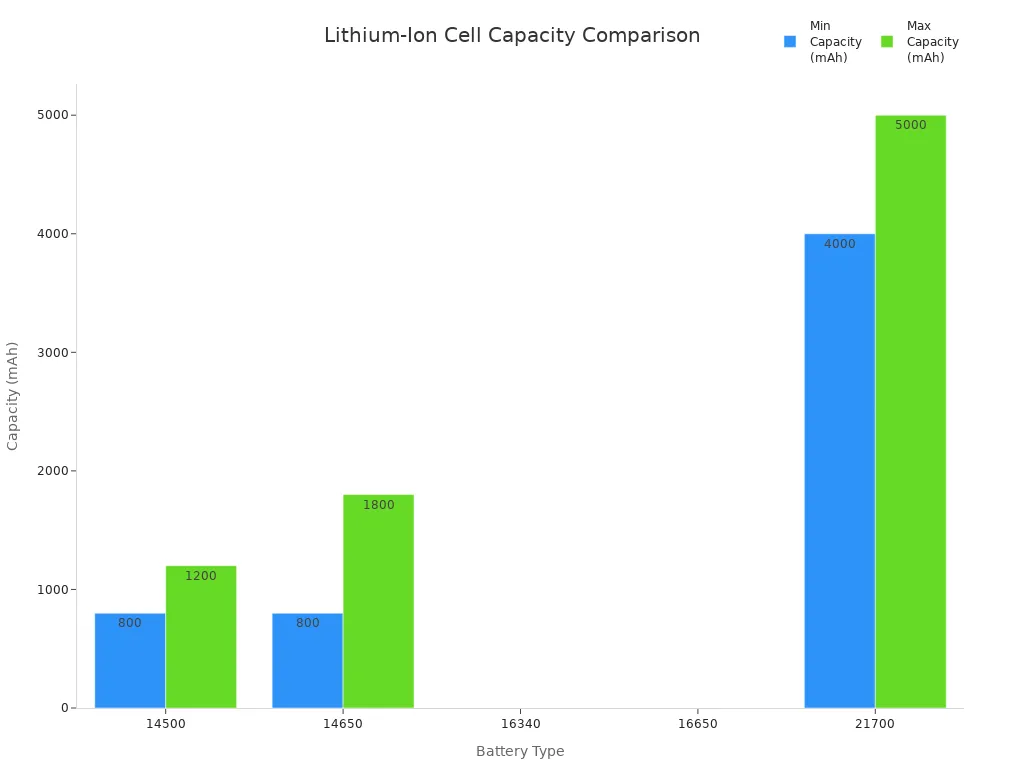
These lithium-ion battery cells offer enough energy for small gadgets while keeping things light and portable. If you build or repair compact electronics, these cells are a great fit.
21700 and 16650 Cells
For high-capacity needs, 21700 cells lead the way. These 3.7v batteries deliver 4000–5000mAh, making them perfect for electric vehicles, power tools, and high-performance flashlights. You get more energy density and longer runtimes compared to smaller cells.
- 21700: 21mm × 70mm, 4000–5000mAh, used in EVs, power tools, and high-drain electronics
- 16650: 16mm × 65mm, 1800–2400mAh, ideal for compact flashlights, medical devices, and UPS systems
Brands like PKCELL offer certified, reliable lithium-ion battery options. If you need a rechargeable battery with high energy density and long life, 21700 cells are a smart choice. 16650 cells work best in space-constrained devices where you still want good performance.
Battery Packs with PCM
Battery packs with PCM (Protection Circuit Module) keep your 3.7v batteries safe. The PCM monitors voltage, current, and temperature, stopping charging or discharging if things get risky. This feature protects your lithium-ion battery from overcharge, over-discharge, short circuits, and overheating.
Popular PCM-equipped products include:
- Enerkey PCM 1S 10A BMS: Handles up to 10A, protects against overcharge/discharge, and works in a wide temperature range.
- Okystar 3.7V 3A PCM BMS: Offers high-accuracy voltage detection and three-stage overcurrent protection.
You’ll find these battery packs in consumer electronics, portable devices, and DIY projects. PCM ensures your rechargeable battery lasts longer and delivers reliable performance.
Custom DIY Battery Assemblies
If you love building your own gadgets, custom DIY battery assemblies let you create the perfect rechargeable battery pack for your needs. You choose the lithium-ion battery cells, connect them with a protection circuit board, and assemble everything in a safe case.
Here’s how you can do it:
- Pick the right battery cells for your energy needs.
- Use a protection circuit board to monitor voltage, temperature, and current.
- Connect everything securely, matching positive and negative terminals.
- Secure the board and wires to prevent movement and short circuits.
- Place the assembly in a protective case with space for heat dissipation.
Safety tip: Always avoid overcharging, overheating, and short circuits. Store unused batteries in a dry, cool place, and stop using any battery that shows signs of damage.
Custom DIY battery assemblies are great for robotics, backup power, and unique electronics projects. You get full control over energy density, capacity, and performance.
Lithium-Ion Battery Reviews
Overview and Features
When you look for a lithium-ion battery, you want something that gives you steady power, lasts a long time, and keeps your devices safe. Many top-rated 3.7V batteries, like the Ansmann 18650, SAMSUNG INR18650-25R, and LG Chem INR18650-MJ1, stand out for their strong performance and safety features. These batteries work well in flashlights, e-bikes, and solar storage systems. They have high energy density, low self-discharge, and can handle many charge cycles. Experts and users both praise these batteries for their reliable performance and long lifespan.
| Battery Model | Capacité (mAh) | Tension nominale | Key Features & Applications | User/Expert Feedback Highlights |
|---|---|---|---|---|
| Ansmann 18650 Lithium-Ion | 2500 | 3.7V | Reliable, low self-discharge, robust build, flashlight use | Praised for long lifespan and dependable performance |
| SAMSUNG INR18650-25R | 2500 | 3.7V | High continuous discharge (20A), suitable for vape devices | Balanced capacity and discharge rate, ~500 charge cycles |
| LG Chem INR18650-MJ1 | 3500 | 3.7V | High energy density, favored for e-bikes and solar storage | Noted for efficiency, reliability, and longevity |
Note: Always check the battery’s safety features before you buy. Look for protection circuits and trusted brands.
Pros and Cons
You want to know what makes a lithium-ion battery great and what you should watch out for. Here’s a quick look at the most common pros and cons:
| Common Pros | Common Cons |
|---|---|
| High capacity for extended use | Larger sizes may not fit all devices |
| Durable with long lifespan | Higher initial cost |
| Consistent performance | Requires specific chargers |
| Rechargeable and eco-friendly | Longer charging times |
| Compatibility with demanding devices | Limited compatibility with some devices |
| Convenience features (USB charging, protection circuits) | Potential shipping restrictions |
You get strong performance, long life, and eco-friendly options. Some batteries cost more at first or take longer to charge. Make sure the battery fits your device and always use the right charger for safety.
Best Use Cases
You can use a 3.7V lithium-ion battery in many devices. Here are some of the best uses:
- Les 18650 lithium-ion battery works well in flashlights, laptops, e-scooters, and power tools.
- Smaller batteries like the 14500 fit compact electronics and low-power gadgets.
- Brands like Samsung, LG, Sony, and Panasonic offer reliable batteries for many needs.
- These batteries give you high energy density and long cycle life. They also work well in hot or cold weather.
- Always follow safety tips. Use the correct charger and avoid over-discharging your rechargeable battery.
Tip: Pick the right size and type for your device to get the best performance and safety.
3.7V Batteries Buyer’s Guide
How to Choose
Picking the right 3.7v batteries can feel tricky, but you can make it simple by matching the specs to your needs. Here’s a quick guide to help you:
- Match the battery’s capacity to your device’s energy use. More capacity means longer runtime.
- Check the size. Make sure the battery fits your device.
- Look at the maximum discharge current. Your battery should handle your device’s peak energy needs.
- Think about the operating temperature. Some batteries work better in hot or cold places.
- Choose batteries with built-in safety circuits for extra protection.
- Pick a form factor that fits your project, like pouch or cylindrical.
- Always use a dedicated charger for 3.7v batteries to keep them healthy.
- Consider the application. Some batteries work best in portable electronics, while others suit DIY projects or sensors.
Tip: Always check for international certifications and safety standards before you buy.
Understanding Specs
You’ll see lots of numbers on a battery label. Here’s what they mean:
| Spec | What It Means | Pourquoi c'est important |
|---|---|---|
| Capacité (mAh) | How much energy the battery stores | More capacity = longer use |
| Voltage (V) | The battery’s power output | Must match your device |
| Taux de décharge | How fast energy leaves the battery | High-drain devices need more |
| Energy Density | How much energy fits in a small space | Higher means lighter devices |
A good lithium battery price guide will help you compare options based on these specs.
Conseils de sécurité
You want your 3.7v batteries to last and stay safe. Here’s a safety guide:
- Use quality chargers with overcharge protection.
- Charge and store batteries between 40-50% capacity for long life.
- Keep batteries in a cool, dry place away from sunlight.
- Never use batteries with damaged wrappers.
- Store batteries in protective cases to prevent short circuits.
- Avoid charging below freezing or above 60°C.
- Always unplug batteries before storage.
Note: Never try to repair a damaged rechargeable battery. Recycle it at a proper center.
Where to Buy
You can find authentic 3.7v batteries at trusted stores like Amazon, Walmart, and Best Buy. For bulk or custom orders, check with manufacturers like BAK Technologies or use platforms such as Alibaba. Always ask for datasheets and certifications. A good lithium battery price guide will help you spot fair deals and avoid fakes.
Remember to recycle old batteries to protect the environment and keep your energy use green.
Battery Recommendations by Need
High-Drain Devices
If you use devices that need a lot of energy fast, like vaping mods or power tools, you want 3.7v batteries that can handle a high discharge rate. Some of the best picks for these jobs include the Molicel P28A, Samsung 25R, and Sony VTC5A. These batteries give you strong energy output and steady performance, so your device never feels weak. The Panasonic NCR18650B is another great pick, offering 3400mAh and reliable energy for longer use. You can also check out the LG HB6 and Sony VTC4 for even more power in high-wattage devices.
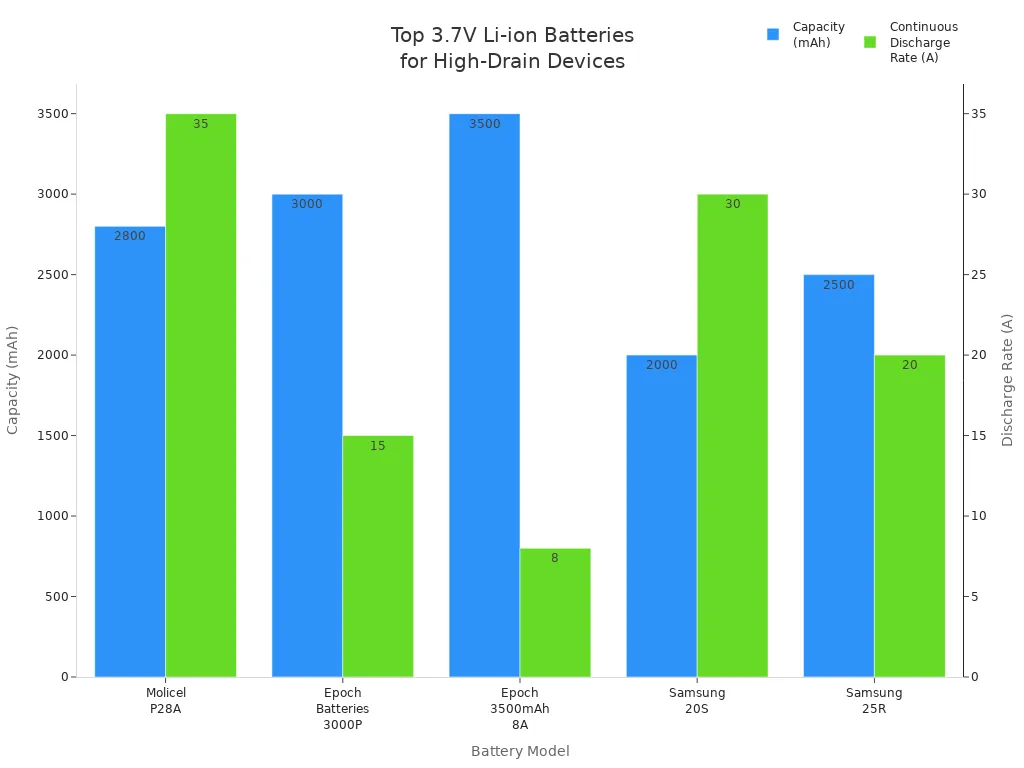
Tip: Always match your battery’s energy output to your device’s needs for the best performance and safety.
Budget Picks
You don’t have to spend a lot to get good energy for your devices. Some of the best picks for budget buyers are LiFePO4 pouch cells and LiPo hard case packs. These batteries last a long time and give you good value for your money. The A123 LiFePO4 cell is a smart choice if you want a battery that can handle higher current. For smaller devices, the Liter Energy 180mAh LiPo is affordable and lightweight. If you need more energy, the Pulse 6000mAh LiPo gives you lots of power at a fair price.
| Product Name | Capacité | Tension | Price | Taux de décharge | Cycle de vie | Weight | Suitable For |
|---|---|---|---|---|---|---|---|
| Liter Energy 180mAh LiPo | 180mAh | 3.7V | $8 | 60C | 300 cycles | 6g | Small RC models, compact devices |
| Pulse 6000mAh LiPo | 6000mAh | 3.7V | $24.99 | 50C | 550 cycles | 32g | High-power devices, drones, power tools |
Look for LiFePO4 chemistry if you want long-lasting energy and a good deal.
DIY Projects
If you like to build your own gadgets, you want batteries that are easy to use and safe. The best picks for diy projects are 18650 cells. These batteries are simple, cost-effective, and work well in single-cell setups. You can use a TP4056 charging module to keep your battery safe from overcharging or short circuits. Always add a protection circuit board to your battery pack. This will shut off the energy if something goes wrong, keeping your project safe. Many diy fans choose 18650 cells because they are easy to find and give you lots of energy for custom builds.
For diy projects, always use a smart charger and a protection board to get the most out of your battery and keep your energy safe.
Compact Electronics
When you need energy for small gadgets like wearables or IoT devices, you want batteries that are light and slim. The best picks here are pouch batteries such as the Ufine 1000mAh or the OCTelect 2400mAh ultra-thin battery. These batteries fit into tight spaces and still give you steady energy. The 3.7V 2000mAh lithium-ion battery is also a good choice for portable devices, offering a balance of size and energy. You can count on these batteries to power your consumer electronics and keep them running for a long time.
| Battery Model | Caractéristiques principales | Application Suitability |
|---|---|---|
| Ufine Lithium-Ion 3.7V 1000mAh Pouch Battery | Compact, lightweight, flexible, reliable energy | Wearables, small gadgets |
| OCTelect 3.7V Polymer Ultra-thin Battery | Ultra-thin, 2400mAh, high performance | Slim electronics, wearable tech |
| YTKavq Lithium Polymer 3.7V 150mAh Battery | Tiny, lightweight, steady energy | Remote controls, micro-apparatus |
Choose a battery that matches your device’s size and energy needs for the best results.
You now know the top 10 types of 3.7V lithium-ion batteries and how to pick the best one for your project. Always match the battery’s size, chemistry, and safety features to your device. Remember to use and store batteries safely—keep them at room temperature and never toss them in the trash. Take old or damaged batteries to a certified recycler. Want to dive deeper? Try building your own battery packs or explore advanced battery chemistry for your next DIY adventure!
FAQ
What makes a 3.7v battery the best for electronics?
You want a battery with high energy density and reliable performance. This gives your electronics longer use between charges. Always check the capacity and safety features. These factors help you get the best for electronics and portable devices.
How do I choose the right rechargeable battery for my DIY project?
Start with a lithium-ion battery that matches your device’s capacity needs. Look at the discharge rate and safety features. A good lithium battery price guide can help you compare picks. Always use a protection circuit for safe DIY builds.
Why do lithium polymer batteries work well in portable devices?
Lithium polymer batteries have a slim shape and high energy density. You can fit them into small spaces. They give you a long-lasting charge and steady battery performance. That’s why you see them in many portable devices and consumer electronics.
What are the main factors to consider when choosing 3.7v batteries?
You should look at capacity, safety, and energy density. Think about the application and the need for a high discharge rate. This guide helps you find the top lithium battery for reliable performance and long life.

